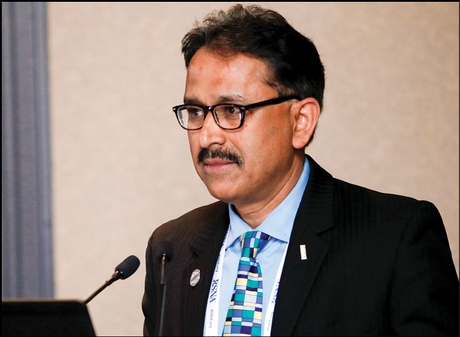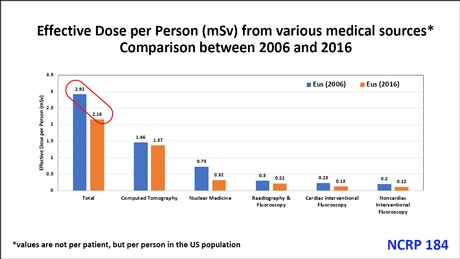Results of a 2019 National Council on Radiation Protection and Measurements (NCRP) report show that the average diagnostic and interventional medical radiation doses are decreasing in the United States (U.S.), according to presenters of a Monday session. The report showed a 15 to 20% reduction in medical radiation doses in the U.S. population from 2006 to 2016.

Mahesh
Along with advancing technology, dose reduction campaigns by radiology organizations including RSNA are contributing factors.
"With the exception of CT scans, most medical imaging doses are stable or decreasing," said Mahadevappa Mahesh, PhD, MS, a professor of radiology and medicine at the Johns Hopkins University School of Medicine.
The 2019 report, entitled, "Medical Radiation Exposure in Patients in the United States" and published by the NCRP in November, analyzed radiation exposure in the U.S. population from 2006 to 2016. It serves as a 10-year update to a 2009 NCRP report that measured medical radiation exposure from the early 1980s to 2006.
Dr. Mahesh, who presented the 2019 NCRP report during a Monday session, co-chaired the report committee with Fred Mettler Jr., MD, professor emeritus and clinical professor at the Department of Radiology and Nuclear Medicine at the University of New Mexico School of Medicine.

A Dramatic Decrease in Dosage
According to the 2009 NCRP report, medical radiation exposure constituted nearly half of the total radiation exposure of the U.S. population. In fact, the 2009 report showed that medical radiation exposure increased nearly six-fold since the previous NCRP report, published in 1987 – a change that was primarily the result of the significant increase in use of CT scanning.
In contrast, the 2019 report shows a dramatic decrease in average radiation dose per person – by as much as 15 to 20%. Specifically, in nuclear medicine, radiation dose per person was reduced by over 50%, mostly due to a decreasing number of procedures.
"As for CT procedures, while the number of CT scans increased by 20% over the decade between the reports, the overall dose per CT exam declined," Dr. Mahesh said.
Radiology Campaigns Contribute to Dose Reduction
The substantial decrease in radiation dose outlined in the 2019 NCRP report can be attributed to several factors. One important change is the technological advances that have yielded hardware improvements and protocols, leading to higher quality images at lower doses. In addition, radiography's shift away from standard film and increased use of digital receptors has resulted in lower radiation doses for some procedures.
Furthermore, efforts by organizations like the U.S. Food and Drug Administration and such dose reduction campaigns as Image Gently and Image Wisely® – programs developed by RSNA, ACR and other radiology associations – have all increased awareness and understanding of medical radiation dose and dose optimization.
"The 2019 NCRP report demonstrates that medical radiation dose in the United States is on the decline, which is a positive shift from a decade ago when doses were increasing significantly," Dr. Mahesh said. "Clearly, the medical community can continue to leverage the benefits of radiological procedures for patients while reducing dose."
Related links:

